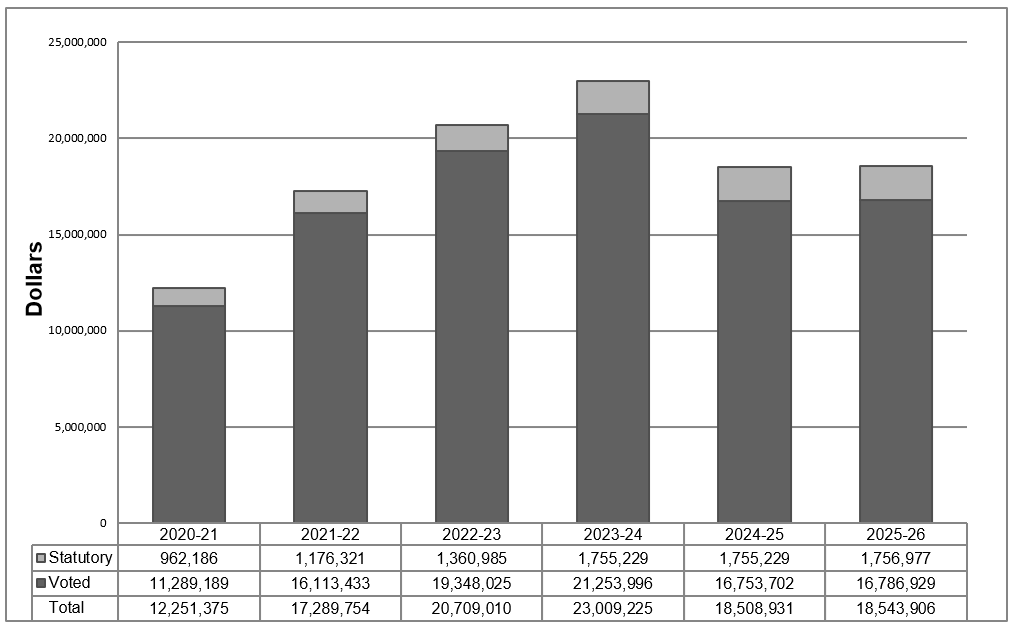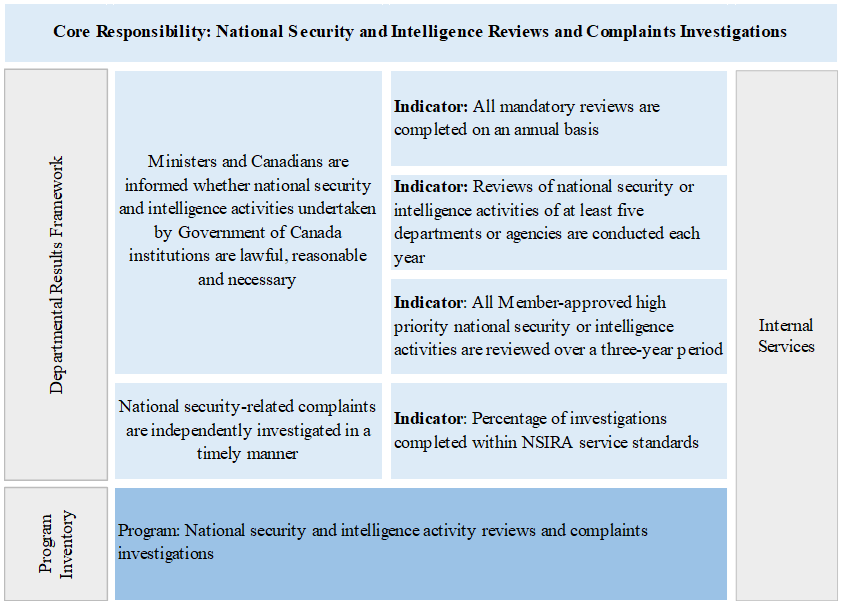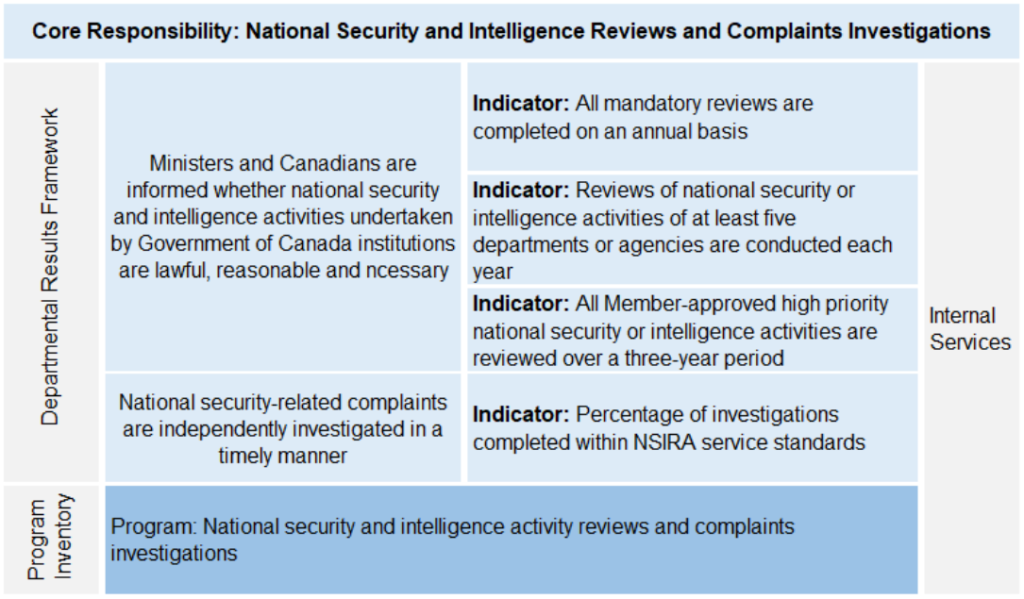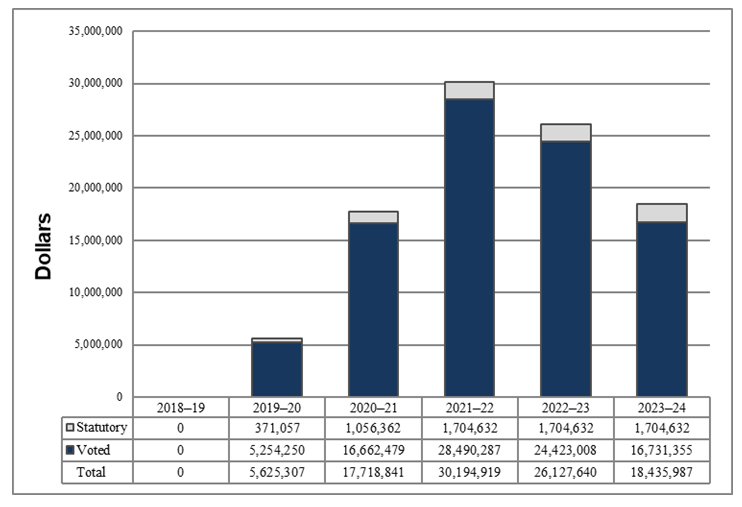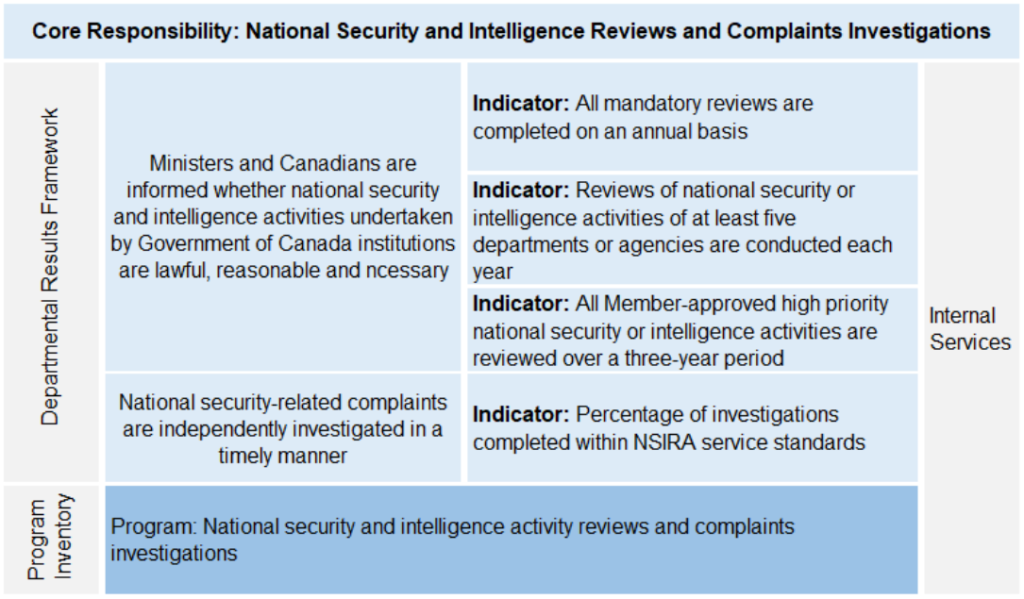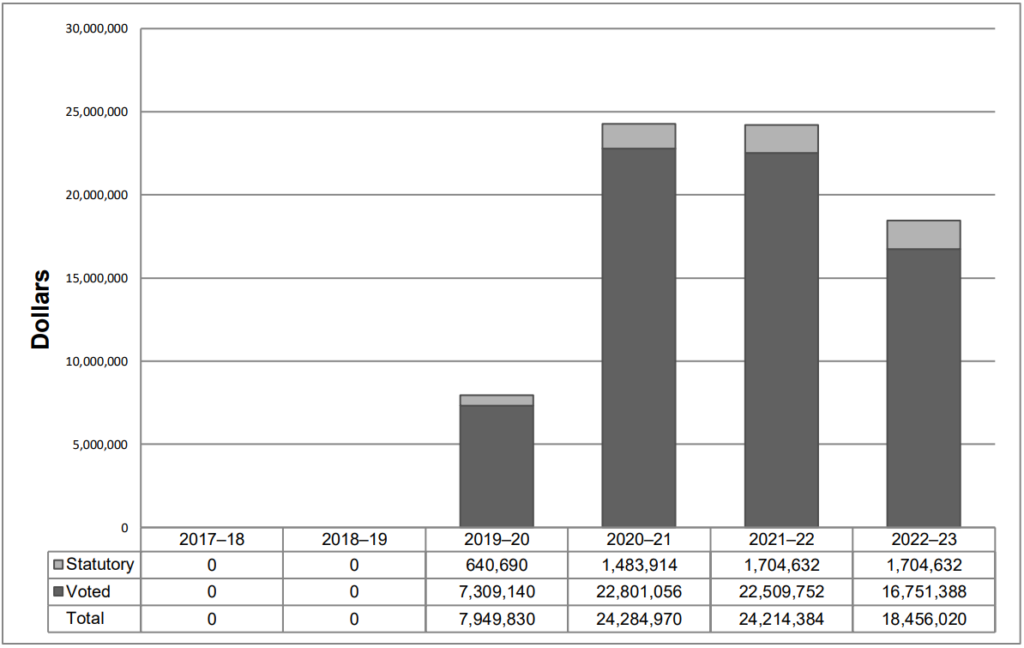Plans at a glance
A departmental plan describes a department’s priorities, plans and associated costs for the upcoming three fiscal years.
- Vision, mission, raison d’etre and operating context
- Minister’s mandate letter
Key priorities
In 2024–25, the NSIRA Secretariat’s top priorities are to
- support NSIRA Members in undertaking professional, independent reviews of Canada’s national security and intelligence activities;
- support NSIRA Members in conducting independent investigations of national security and intelligence public complaints;
- provide transparency about our work; and
- continue to strengthen our domestic and international partnerships.
Refocusing Government Spending
In Budget 2023, the government committed to reducing spending by $14.1 billion over the next five years, starting in 2023–24, and by $4.1 billion annually after that.
While not officially part of the government spending reduction exercise, the NSIRA Secretariat will respect the spirit of this exercise by
- critically considering the need for contractors, and
- identifying work that can be done in-house or deferred, if required.
NSIRA remains committed to managing spending with prudence and probity and that resources are used effectively, and efficiently to achieve organizational objectives.
Highlights
A Departmental Results Framework consists of an organization’s core responsibilities, the results it plans to achieve, and the performance indicators that measure progress toward these results.
National security and intelligence reviews and complaints investigations
Departmental results:
NSIRA reviews Government of Canada national security and intelligence activities to assess whether they are lawful, reasonable, and necessary. The Agency also investigates complaints from members of the public on the activities of the Canadian Security Intelligence Service (CSIS), the Communications Security Establishment (CSE), the Royal Canadian Mounted Police (RCMP), as well as certain other national security-related complaints, independently and in a timely manner.
The NSIRA Secretariat supports the Agency in the delivery of its mandate. Independent scrutiny contributes to strengthening the accountability framework for national security and intelligence activities and to enhancing public confidence. Ministers and Canadians are informed whether national security and intelligence activities undertaken by Government of Canada institutions are lawful, reasonable, and necessary.
See GC InfoBase for the full framework and program inventory.
Planned spending: $10,852,987
Planned human resources: 69
Support to national security and intelligence reviews and complaints investigations: The NSIRA Secretariat will support the Agency as it ensures institutions’ accountability and enhances public confidence. This will involve conducting transparent and timely investigations into complaints related to national security or intelligence activities and the denial of security clearances.
Throughout 2024–25, the NSIRA Secretariat will support and conduct the Agency’s current reviews and initiate new reviews as per its Forward Review Plan. It will also conduct the Agency’s mandated annual reviews under the National Security and Intelligence Review Agency Act and annual reviews of CSIS and CSE activities.
For more information on the NSIRA Secretariat’s plans, see the “Plans to deliver” section of this plan.
More information about National security and intelligence reviews and complaints investigations can be found in the full departmental plan.
Date of Publishing:
From the Executive Director
This Departmental Plan describes the priorities and goals for the National Security and Intelligence Review Agency (NSIRA) Secretariat in 2024–25. Our work is fundamentally anchored by our role in supporting the Agency’s mandate to undertake independent, expert review and investigation of the Government of Canada’s national security and intelligence activities.
Since the Agency’s inception in 2019, the NSIRA Secretariat has worked to establish a professional workforce and the supporting infrastructure, processes, and policies needed to carry out its mandate. Our approaches have matured as we have taken time for deep internal reflection and to consult with our domestic and international partners. Combined with the growing willingness of the national security community to genuinely accept and adjust to our mandate, we are now well positioned to leverage what we have learned and confidently advance our work as a world-recognized review body. In so doing, we will continue to work towards NSIRA’s vision of an accountable, transparent, and effective national security and intelligence community that upholds the rule of law.
In 2024–25, the Secretariat will continue to improve the quality of our working environment to attract and retain an exceptional workforce. We recognize that prioritizing the physical and mental well-being of our employees, and continuing to advance diversity and inclusion, are important aspects of becoming an employer of choice. We have taken steps to implement meaningful action in the coming year. NSIRA is well positioned to take on new and exciting challenges in the year ahead. I would like to thank both Secretariat staff and NSIRA Members, whose ongoing professionalism and dedication to our important work continues to be the force behind our past and future success.
John Davies
Executive Director
National Security and Intelligence Review Agency Secretariat
Plans to deliver on core responsibilities and internal services
Core responsibilities and internal services:
- National security and intelligence reviews and complaints investigations
- Internal services
National security and intelligence reviews and complaints investigations
Description
NSIRA reviews Government of Canada national security and intelligence activities to assess whether they are lawful, reasonable, and necessary. The Agency investigates complaints from members of the public regarding activities of CSIS, CSE, and the national security activities of the RCMP, as well as certain other national security-related complaints.
The NSIRA Secretariat supports the Agency in the delivery of this mandate. The resulting independent scrutiny contributes to the strengthening of the framework of accountability for national security and intelligence activities undertaken by Government of Canada institutions and enhancing public confidence.
Quality of life impacts
NSIRA’s core responsibility relates most closely to the indicator ‘confidence in institutions’, within the ‘democracy and institutions’ sub domain and under the overarching domain of ‘good governance’.
Results and targets
The following tables show, for each departmental result related to national security and intelligence reviews and complaints investigations, the indicators, the results from the three most recently reported fiscal years, the targets and target dates approved in 2024–25.
Table 1: Indicators, results and targets for departmental result “Ministers and Canadians are informed whether national security and intelligence activities undertaken by Government of Canada institutions are lawful, reasonable, and necessary”
| Indicator | 2020–21 result | 2021–22 result | 2022–23 result | Target | Date to achieve |
|---|---|---|---|---|---|
| All mandatory reviews are completed on an annual basis | N/A | 100% | 100% | 100% completion of mandatory reviews | December 2022 |
| Reviews of national security or intelligence activities of at least five departments or agencies are conducted each year | N/A | 100% | 100% | At least one national security or intelligence activity is reviewed in at least five departments or agencies annually | December 2022 |
| All Member-approved high priority national security or intelligence activities are reviewed over a three- year period | N/A | 33% | 33% | 100% completion over three years; at least 33% completed each year | December 2022 |
Table 2: Indicators, results, and targets for departmental result “National security-related complaints are independently investigated in a timely manner”
| Indicator | 2020–21 result | 2021–22 result | 2022–23 result | Target | Date to achieve |
|---|---|---|---|---|---|
| Note: NSIRA was created on July 12, 2019. Actual results for 2020–21 are not available because the new Departmental Results Framework was being developed during the transition of the Security Intelligence Review Committee into the establishment of NSIRA. The new framework is for measuring and reporting on results achieved starting in 2021–22; in 2022–23, NSIRA finalized service standards on the time required to complete its investigations (effective April 1, 2023). The results will be included in the next Departmental Results Report. | |||||
| Percentage of investigations completed within NSIRA service standards | N/A | N/A | N/A | 90% – 100% | March 2024 |
The financial, human resources and performance information for NSIRA’s program inventory is available on GC InfoBase.
Plans to achieve results
Support to NSIRA reviews
The NSIRA Secretariat will continue to support the Agency’s current, ongoing reviews and new reviews from the Forward Review Plan throughout 2024–25. This will include supporting the annual reviews of CSIS and CSE activities, to provide responsible Ministers and the Canadian public with an assessment of these institutions’ activities, including their lawfulness, reasonableness, and necessity.
In 2024–25, the NSIRA Secretariat will continue to be informed and guided by the knowledge acquired through reviews of departments and agencies (reviewees) to date. As it becomes increasingly familiar with reviewees’ organizational structures, networks, policies, and activities, and able to apply such information to subsequent reviews, it will leverage this knowledge to ensure these institutions’ national security and intelligence activities are reviewed from a strongly informed position of independence. The NSIRA Secretariat will also continue to support reviews focused on crosscutting, horizontal issues that span multiple reviewees, with a goal of fully leveraging NSIRA’s authority in this regard.
In addition to conducting its mandated annual reviews in 2024-25, the NSIRA Secretariat will lead the development of a new review plan that is timely, topical, and responsive. The Forward Review Plan involves evaluating proposals for new reviews against an established matrix of criteria. The criteria represent the considerations or aspects that NSIRA deems to be the most important and relevant to the issues and topics it addresses through its discretionary reviews. The outcome will be a prioritized list of new reviews that will be undertaken once the existing reviews are completed. In this way, the NSIRA Secretariat will continue to support NSIRA Members in executing their responsibilities and exercising their authority under the NSIRA Act.
Support to NSIRA complaints investigations
In 2024–25, the NSIRA Secretariat will support the Agency in ensuring institutions’ accountability and enhancing public confidence by conducting transparent and timely investigations into complaints related to national security and the denial of security clearances. NSIRA’s independent investigation of complaints plays a critical role in maintaining public access to justice.
In the coming year, the NSIRA Secretariat will apply its rules of procedure, which were first implemented in 2021, to promote accessibility, timeliness, and efficiency in the Agency’s investigation of complaints. This includes an informal resolution process that has proven successful in resolving complaints that do not need to proceed e to formal investigation process.
The NSIRA Secretariat will further implement the Agency’s new service standards for the investigation of complaints, which were created in 2022–23 and effective as of April 1, 2023.
Transparency
The NSIRA Secretariat will continue to proactively publish unclassified versions of all Agency review reports. It will engage reviewees in a timelier manner on release approvals and aim to publish redacted reports on the NSIRA website shortly after these reports are provided to reviewees and their respective Ministers, leveraging processes developed during the previous year.
Partnerships
Participation
In 2024–25, the NSIRA Secretariat will build on its ongoing partnership efforts from the previous year. It will continue its participation in the Five Eyes Intelligence Oversight and Review Council, which brings together review agency representatives from Canada, the United States, Australia, New Zealand, and the United Kingdom.
Engagement
The NSIRA Secretariat will also continue to support multilateral and bilateral engagement with other like-minded European and international partners. Such participation and engagement will include ongoing working-level visits and exchanges. This work will support NSIRA’s interest in benefiting from, and contributing to, the sharing of best practices with the broader review and oversight community. The NSIRA Secretariat will also continue to build on recent efforts to foster collaborative relationships with other domestic review bodies and civil society groups.
Key risks
The NSIRA Secretariat has made progress on accessing the information required to conduct reviews; however, there continues to be risks associated with reviewees’ ability to respond to, and prioritize, information requests, hindering NSIRA’s ability to deliver its review plan in a timely way. The NSIRA Secretariat will continue to mitigate this risk by providing clear communication related to information requests, tracking their timely completion within communicated timelines, and escalating issues when appropriate.
Snapshot of planned resources in 2024–25
- Planned spending: $18,575,110
- Planned full-time resources: 100
Related government priorities
In 2024–25, the NSIRA Secretariat will continue to implement its three-year action plan on human rights, accessibility, employment equity, diversity, and inclusion. It first put this plan into effect during fiscal year 2022–23, following a maturity assessment of its policies, programs, and practices, and the Call to Action from the Clerk of the Privy Council. It includes, among many components, incorporating a gender-based analysis plus lens into the design and implementation of the NSIRA Secretariat’s policies and programs.
Employee self-identification data, which was first collected by the NSIRA Secretariat in 2023–2024 (further to the establishment of a special program under the Canadian Human Rights Act), will continue to inform the NSIRA Secretariat’s activities in the year ahead and better position it to:
- prevent, eliminate, or reduce disadvantages and barriers that are experienced by any group of individuals based on, or related to, prohibited grounds of discrimination;
- identify gaps in representation, to implement recruitment and retention measures aimed at not only achieving but retaining a diverse workforce and maintaining an inclusive work environment;
- leverage the value of diverse peoples and perspectives in its work; and
- identify meaningful opportunities for employee engagement in keeping with its overall commitment to human rights, accessibility, employment equity, diversity, and inclusion.
NSIRA’s Forward Looking Review Plan continues to be informed by considerations related to anti-racism, equity, and inclusion. These considerations apply to the process of selecting reviews to be undertaken, as well as to the analysis that takes place during individual reviews. NSIRA reviews routinely take into account the potential for national security or intelligence activities to result in disparate outcomes for various communities, and will continue to do so in the year ahead.
In 2024–25, in the context of complaint investigations, the NSIRA Secretariat will continue to support the Agency as it works with the Civilian Review and Complaints Commission (CRCC) to develop strategies for the collection, analysis, and use of identity-based data. Following the completion of a joint study, it will focus on assessing how some recommendations can be implemented for the collection, analysis, and use of identity-based data in relation to the NSIRA and CRCC mandates.
The NSIRA Secretariat will also continue to implement its Accessibility Plan, which outlines the steps that will be taken to increase accessibility within the organization and for all Canadians over the next two years. In addition, its Diversity, Inclusion, and Employment Equity Advisory Committee will continue to work with management and staff to build a more equitable, diverse, and inclusive workplace and workforce. This will include organizing discussions and learning events with all staff and providing advice on policy and program design.
In the year ahead, the NSIRA Secretariat will also develop and implement a pay equity plan, as required by the Pay Equity Act. Closing any identified gender pay gap is essential to advancing gender equality and fostering a workplace driven by inclusivity and fairness.
Program inventory
National security and intelligence reviews and complaints investigations are supported by the following program in the program inventory:
- National security and intelligence activity reviews and complaints investigations.
Supporting information on planned expenditures, human resources, and results related to NSIRA’s program inventory is available on GC Infobase.
Internal services
Description
Internal services are the services that are provided within a department so that it can meet its corporate obligations and deliver its programs. There are 10 categories of internal services:
- management and oversight services
- communications services
- human resources management services
- financial management services
- information management services
- information technology services
- real property management services
- materiel management services
- acquisition management services
Plans to achieve results
In 2024–25, the NSIRA Secretariat will continue to take steps to ensure resources are deployed in the most effective and efficient manner possible, and its operations and administrative structures, tools, and processes continue to focus on supporting the delivery of its priorities.
The NSIRA Secretariat recognizes the need to be an inclusive, healthy, and flexible employer. Over the coming year, it will continue to encourage flexible working arrangements, such as teleworking, to achieve work–life balance and meet performance expectations.
In the coming year, the NSIRA Secretariat’s office footprint, with modern and flexible workstations in the classified and non-classified realm, is expected to be completed. The project has been pushed back to a summer 2024 delivery date due to its complexity, supply chain challenges, and compliance requirements.
The NSIRA Secretariat also continues to implement security controls and keeps its Security Plan and Business Impact Analysis evergreen, to ensure resiliency over time. In addition, based on the NSIRA Secretariat’s Information Management plans and strategies developed last fiscal year, it has identified the tools and resources required to execute the plans and strategies over the coming years.
Snapshot of planned resources in 2024-25
- Planned spending: $7,722,123
- Planned full-time resources: 31
Related government priorities
Planning for contracts awarded to Indigenous businesses
The NSIRA Secretariat is among the final wave of departments and agencies that are to achieve the mandatory minimum target of contract awards to Indigenous businesses by 2024–25. Efforts are already well underway in support of the Government of Canada’s commitment which requires that an annual, mandatory minimum target of five percent of the total value of contracts be awarded to Indigenous businesses.
In 2021-22, the NSIRA Secretariat exceeded its plan to reach two percent of total contract values awarded to Indigenous business, and achieved three percent, as shown in Table 3. Measures undertaken by the NSIRA Secretariat to facilitate the achievement of the mandatory minimum target by 2024–25 include a commitment to process an increasing minimum number of contracts in each of the following three fiscal years, as set-asides under the Procurement Strategy for Indigenous Business.
Table 3: Progress toward target for contracts with Indigenous businesses
| 5% reporting field description | 2021–22 actual % achieved | 2022–23 actual % achieved | 2023–24 planned % target | 2024–25 planned % target |
|---|---|---|---|---|
| Total percentage of contracts with Indigenous businesses | 3% | 3% | 3% | 5% |
Planned spending and human resources
This section provides an overview of NSIRA’s planned spending and human resources for the next three fiscal years and compares planned spending for 2024–25 with actual spending from previous years.
Spending
Table 4: Actual spending summary for core responsibilities and internal services ($ dollars)
The following table shows information on spending for each of NSIRA’s core responsibilities and for its internal services for the previous three fiscal years. Amounts for the current fiscal year are forecasted based on spending to date.
| Core responsibilities and Internal Services | 2020–21 actual expenditures | 2021–22 actual expenditures | 2022–23 forecast spending |
|---|---|---|---|
| National Security and Intelligence Reviews and Complaints Investigations | 7,394,642 | 7,756,271 | 9,516,920 |
| Subtotal | 7,394,642 | 7,756,271 | 9,516,920 |
| Internal Services | 9,895,112 | 10,532,876 | 10,799,513 |
| Total | 17,289,754 | 18,289,147 | 20,316,433 |
Table 5: Budgetary planning summary for core responsibilities and internal services (dollars)
The following table shows information on spending for each of NSIRA’s core responsibilities and for its internal services for the upcoming three fiscal years.
| Core responsibilities and Internal Services | 2024–25 budgetary spending (as indicated in Main Estimates) | 2024–25 planned spending | 2025–26 planned spending | 2026–27 planned spending |
|---|---|---|---|---|
| National Security and Intelligence Reviews and Complaints Investigations | 10,852,987 | 10,852,987 | 10,852,051 | 10,852,051 |
| Subtotal | 10,852,987 | 10,852,987 | 10,852,051 | 10,852,051 |
| Internal Services | 7,722,123 | 7,722,123 | 7,758,034 | 7,758,034 |
| Total | 18,575,110 | 18,575,110 | 18,610,085 | 18,610,085 |
Funding
Figure 1: Departmental spending 2021–22 to 2026–27
The following graph presents planned spending (voted and statutory expenditures) over time.
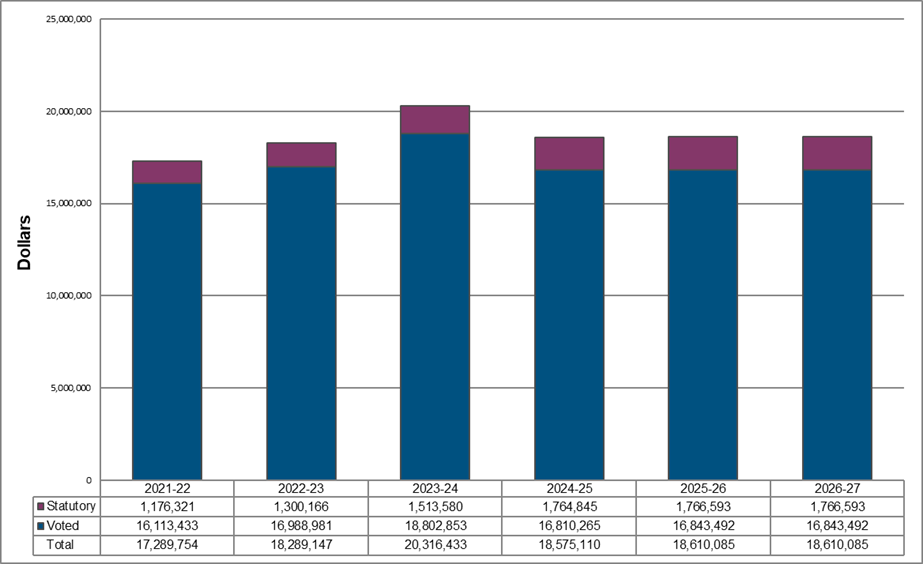
Text version of Figure 1
| 2021–22 | 2022–23 | 2023–24 | 2024–25 | 2025–26 | 2026–27 | |
|---|---|---|---|---|---|---|
| Statutory | 1,176,321 | 1,300,166 | 1,513,580 | 1,764,845 | 1,766,593 | 1,766,593 |
| Voted | 16,113,433 | 16,988,981 | 18,802,853 | 16,810,265 | 16,843,492 | 16,843,492 |
| Total | 17,289,754 | 18,289,147 | 20,316,433 | 18,575,110 | 18,610,085 | 18,610,085 |
Peak spending was reached in 2023–24 with the inclusion of the majority of construction project expenditures. The NSIRA Secretariat will move to steadier state of spending in 2024–25.
Estimates by vote
Information on NSIRA’s organizational appropriations is available in the 2024–25 Main Estimates.
Future-oriented condensed statement of operations
The future-oriented condensed statement of operations provides an overview of NSIRA’s operations for 2023–24 to 2024–25.
The forecast and planned amounts in this statement of operations were prepared on an accrual basis. The forecast and planned amounts presented in other sections of the Departmental Plan were prepared on an expenditure basis. Amounts may therefore differ.
A more detailed future-oriented statement of operations and associated notes, including a reconciliation of the net cost of operations with the requested authorities, are available at NSIRA’s website.
Table 6: Future-oriented condensed statement of operations for the year ending March 31, 2025 (dollars)
| Financial information | 2023–24 Forecast results | 2024–25 Planned results | Difference (2024–25 planned results minus 2023–24 Forecast results) |
|---|---|---|---|
| Total expenses | 18,786,869 | 20,400,691 | 1,613,823 |
| Total revenues | 0 | 0 | 0 |
| Net cost of operations before government funding and transfers | 18,786,869 | 20,400,691 | 1,613,823 |
Human resources
Table 7: Actual human resources for core responsibilities and internal services
The following table shows a summary of human resources, in full-time equivalents (FTEs), for NSIRA’s core responsibilities and for its internal services for the previous three fiscal years. Human resources for the current fiscal year are forecasted based on year to date.
| Core responsibilities and Internal Services | 2021–22 actual full time equivalents | 2022–23 actual full time equivalents | 2023–24 forecast full time equivalents |
|---|---|---|---|
| National Security and Intelligence Reviews and Complaints Investigations | 52 | 53 | 69 |
| Subtotal | 52 | 53 | 69 |
| Internal Services | 22 | 25 | 31 |
| Total | 74 | 78 | 100 |
Given the NSIRA secretariat continues to be a growing organization, the increase of 4 FTEs is reasonable year over year. The organization plans to continue to grow towards 100 FTEs through various recruitment and retention programs.
Table 8: Human resources planning summary for core responsibilities and internal services
The following table shows information on human resources, in full-time equivalents (FTEs), for each of NSIRA’s core responsibilities and for its internal services planned for 2024–25 and future years.
| Core responsibilities and Internal Services | 2024–25 planned full time equivalents | 2025–26 planned full time equivalents | 2026–27 planned full time equivalents |
|---|---|---|---|
| National Security and Intelligence Reviews and Complaints Investigations | 69 | 69 | 69 |
| Subtotal | 69 | 69 | 69 |
| Internal Services | 31 | 31 | 31 |
| Total | 100 | 100 | 100 |
With a tight labour market and the requirement for a significant portion of employees to work primarily from secure office space, recruitment continues to prove challenging. New recruitment and retention programs will help the NSIRA secretariat in its ongoing efforts to be fully staffed.
Corporate Information
Organizational profile
Appropriate minister: The Right Honourable Justin Trudeau, Prime Minister of Canada
Institutional head: John Davies, Executive Director
Ministerial portfolio: Privy Council Office
Enabling instrument: National Security and Intelligence Review Agency Act
Year of incorporation / commencement: 2019
Organizational contact information
National Security and Intelligence Review Agency
P.O. Box 2430, Station “D” Ottawa, Ontario
K1P 5W5
Telephone: The phone number is temporarily disabled
Fax: The fax number is temporarily disabled.
Email: info@nsira-ossnr.gc.ca
Website: www.nsira-ossnr.gc.ca
Supplementary information tables
Information on NSIRA’s departmental sustainable development strategy can be found on NSIRA’s website
Federal tax expenditures
NSIRA’s Departmental Plan does not include information on tax expenditures.
Tax expenditures are the responsibility of the Minister of Finance. The Department of Finance Canada publishes cost estimates and projections for government wide tax expenditures each year in the Report on Federal Tax Expenditures.
This report provides detailed information on tax expenditures, including objectives, historical background and references to related federal spending programs, as well as evaluations, research papers and gender-based analysis plus.
Appendix: definitions
appropriation (crédit)
Any authority of Parliament to pay money out of the Consolidated Revenue Fund.
budgetary expenditures (dépenses budgétaires)
Operating and capital expenditures; transfer payments to other levels of government, organizations or individuals; and payments to Crown corporations.
core responsibility (responsabilité essentielle)
An enduring function or role performed by a department. The intentions of the department with respect to a core responsibility are reflected in one or more related departmental results that the department seeks to contribute to or influence.
Departmental Plan (plan ministériel)
A report on the plans and expected performance of an appropriated department over a 3‑year period. Departmental Plans are usually tabled in Parliament each spring.
departmental priority (priorité)
A plan or project that a department has chosen to focus and report on during the planning period. Priorities represent the things that are most important or what must be done first to support the achievement of the desired departmental results.
departmental result (résultat ministériel)
A consequence or outcome that a department seeks to achieve. A departmental result is often outside departments’ immediate control, but it should be influenced by program-level outcomes.
departmental result indicator (indicateur de résultat ministériel)
A quantitative measure of progress on a departmental result.
departmental results framework (cadre ministériel des résultats)
A framework that connects the department’s core responsibilities to its departmental results and departmental result indicators.
Departmental Results Report (rapport sur les résultats ministériels)
A report on a department’s actual accomplishments against the plans, priorities and expected results set out in the corresponding Departmental Plan.
experimentation (expérimentation)
The conducting of activities that seek to first explore, then test and compare the effects and impacts of policies and interventions in order to inform evidence-based decision-making, and improve outcomes for Canadians, by learning what works, for whom and in what circumstances. Experimentation is related to, but distinct from innovation (the trying of new things), because it involves a rigorous comparison of results. For example, using a new website to communicate with Canadians can be an innovation; systematically testing the new website against existing outreach tools or an old website to see which one leads to more engagement, is experimentation.
full‑time equivalent (équivalent temps plein)
A measure of the extent to which an employee represents a full person‑year charge against a departmental budget. For a particular position, the full‑time equivalent figure is the ratio of number of hours the person actually works divided by the standard number of hours set out in the person’s collective agreement.
gender-based analysis plus (GBA Plus) (analyse comparative entre les sexes plus [ACS Plus])
An analytical process used to assess how diverse groups of women, men and gender-diverse people experience policies, programs and services based on multiple factors including race ethnicity, religion, age, and mental or physical disability.
government-wide priorities (priorités pangouvernementales)
For the purpose of the 2020–21 Departmental Results Report, those high-level themes outlining the government’s agenda in the 2019 Speech from the Throne, namely: Fighting climate change; Strengthening the Middle Class; Walking the road of reconciliation; Keeping Canadians safe and healthy; and Positioning Canada for success in an uncertain world.
horizontal initiative (initiative horizontale)
An initiative where two or more federal organizations are given funding to pursue a shared outcome, often linked to a government priority.
non‑budgetary expenditures (dépenses non budgétaires)
Net outlays and receipts related to loans, investments and advances, which change the composition of the financial assets of the Government of Canada.
performance (rendement)
What an organization did with its resources to achieve its results, how well those results compare to what the organization intended to achieve, and how well lessons learned have been identified.
performance indicator (indicateur de rendement)
A qualitative or quantitative means of measuring an output or outcome, with the intention of gauging the performance of an organization, program, policy or initiative respecting expected results.
performance reporting (production de rapports sur le rendement)
The process of communicating evidence‑based performance information. Performance reporting supports decision making, accountability and transparency.
plan (plan)
The articulation of strategic choices, which provides information on how an organization intends to achieve its priorities and associated results. Generally, a plan will explain the logic behind the strategies chosen and tend to focus on actions that lead to the expected result.
planned spending (dépenses prévues)
For Departmental Plans and Departmental Results Reports, planned spending refers to those amounts presented in Main Estimates.
A department is expected to be aware of the authorities that it has sought and received. The determination of planned spending is a departmental responsibility, and departments must be able to defend the expenditure and accrual numbers presented in their Departmental Plans and Departmental Results Reports.
program (programme)
Individual or groups of services, activities or combinations thereof that are managed together within the department and focus on a specific set of outputs, outcomes or service levels.
program inventory (répertoire des programmes)
Identifies all the department’s programs and describes how resources are organized to contribute to the department’s core responsibilities and results.
result (résultat)
A consequence attributed, in part, to an organization, policy, program or initiative. Results are not within the control of a single organization, policy, program or initiative; instead they are within the area of the organization’s influence.
statutory expenditures (dépenses législatives)
Expenditures that Parliament has approved through legislation other than appropriation acts. The legislation sets out the purpose of the expenditures and the terms and conditions under which they may be made.
target (cible)
A measurable performance or success level that an organization, program or initiative plans to achieve within a specified time period. Targets can be either quantitative or qualitative.
voted expenditures (dépenses votées)
Expenditures that Parliament approves annually through an appropriation act. The vote wording becomes the governing conditions under which these expenditures may be made.


